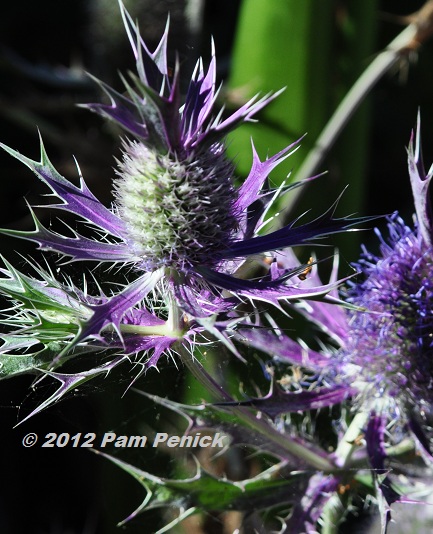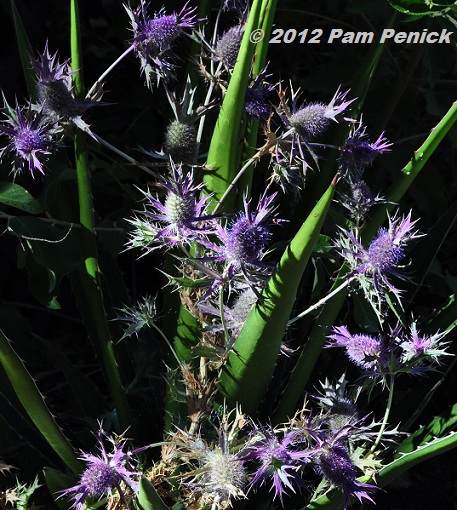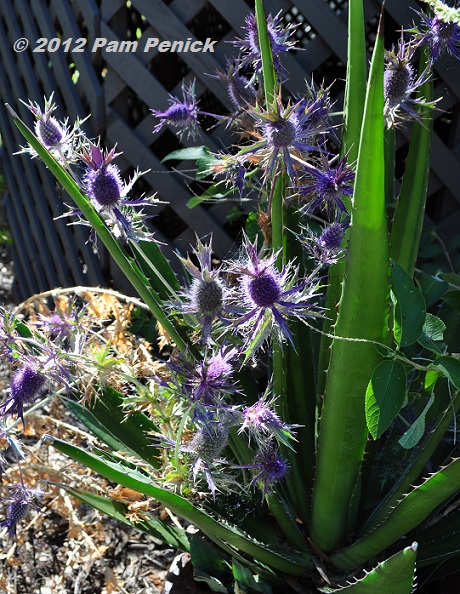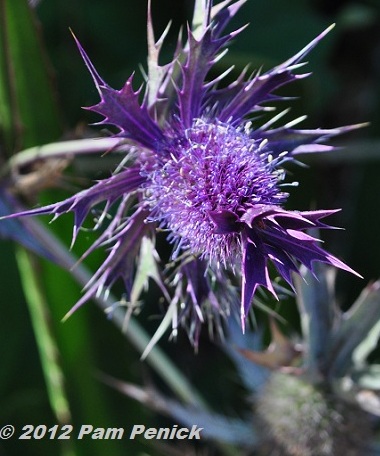Plant This: Leavenworth’s eryngo spikes the fall garden
Michael of Plano Prairie Garden, this is for you. Now that purple pineapples in spiky ballerina skirts and crowns are dancing in my garden, I have Michael to thank. During my visit to his garden last October, he gave me some seedheads from Eryngium leavenworthii, the native Texas eryngo he grows in his front-yard prairie each year.
I sowed the seeds this spring in the sunny hillside garden, which gets a lot of reflected heat and not much water. And then I forgot about them, as I do all seeds that I sow. Luckily we had a wet early spring, which helped them get established when I forgot to water. When the first seedlings came up, I pulled a few, mistaking them for weeds before I remembered what they were. (This always happens when I plant seeds.) All summer the rather rank, weedy looking foliage grew, and I dutifully left it alone. Now comes the payoff! I just love those purple, spiky blooms.
Eryngo flops in my garden, probably due to too much shade. It’s handy to grow it near another plant it can lean on for support, like this potted Agave lophantha, whose sword-like leaves prop up the floppy eryngo. You can see, on the left, its brown, weedy looking stems and lower leaves. It would be good to plant eryngo behind a mid-sized perennial that could hide its skinny legs—maybe Salvia greggii or little bluestem.
No matter. I’m really enjoying these spiny annuals, whose purple bracts have a royal intensity of color. I tend to mulch too heavily to get returning seedlings, so I’ll probably collect the browned seedheads later this fall and sow seeds in bare, gravelly soil again next spring.
All material © 2006-2012 by Pam Penick for Digging. Unauthorized reproduction prohibited.






If the seedheads are as spiky as the ones on my Jade Frost Eryngium, you might want to be harvest the seeds with tweezers. They are very poky. Yours look almost like Spanish lavender on steroids. What a great plant!
That is the coolest looking plant and purple to boot. I’m definitely planting that next spring.
Love those! they are gorgeous! going to have to get some for my garden next year!
The first time I saw an Eryngium leavenworthii was in the Kansas State Botanical Garden. Love the purple!!!
Pam, my eryngo are in full sun and most of them flop to some degree. On my way to work, I drive by the field where I collected my seeds. The wild siblings of our plants stand straight up on a single, unbranched stem and are less than two feet tall. Some of the plants in my garden get over four feet tall! I think the additional water and fertility in the garden causes the additional growth. I do have one cute little plant growing in decomposed granite in my parkway that is only two inches tall and is topped with a single flower. I am going try to get a picture of the wild plants this weekend and post a comparison to the plants in my garden.
Thanks for the additional info about their growth habit in the wild, Michael. —Pam
I love them. Are the seeds in the trade or are they strictly pass-along?
I don’t know, Laura. I haven’t looked for them in stores. If you want to send me your address, I can mail you some later this fall. —Pam
That’s a good example of a plant that looks better from a slight distance. It’s fascinating up close, too, but the color and spiky nature of the blooms really makes it pop when you look at the plant in its entirety. What a fun plant!
These grew wild in the fields all around my childhood home in Killeen, Tx. As another poster noted, the wild ones are quite upright. While they are beautiful, they are also very painful if you happen to brush up against one!
For some reason the first thought that came to mind when I saw your photos is that they would probably make Eeeyore happy!
The seeds are commercially available, but an October ride into the sticks can probably yield a huge quantity, if one keeps a sharp look out. 🙂